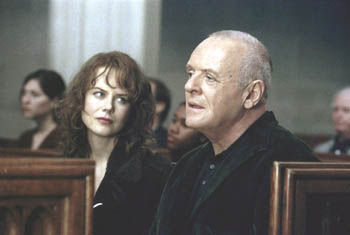![[Metroactive Movies]](/gifs/movies468.gif)
[ Movies Index | Show Times | Santa Cruz | Metroactive Home | Archives ]
Are You Kidman Me?: 'For chrissakes, Tony, cut out the "Hello, Clarice" crap. That was Julianne Moore.'
Passing Zone
Anthony Hopkins turns racial classifications upside down in film adaptation of Philip Roth's 'The Human Stain'
By Richard von Busack
A very nice gent named Allison Johnston showed up at the San Francisco preview of The Human Stain. Johnston, the film's second assistant director, was there, it seemed, to defuse the racial controversy over the film. The Human Stain's actual director, Robert Benton (Places of the Heart), guilefully introduced Johnston to the crowd at the beginning of the screening, asking us to remember his face.
Johnston is in the movie too, but don't blink. He has a one-line part as a customer aboard a railroad car sometime in the 1940s. He's flagging down a black waiter ("Boy, take this fish back; it's overcooked"). Even a Klansman wouldn't spot Johnston as who he is: the child of two black parents. Thus he's an example to those outraged that Anthony Hopkins is playing someone who isn't white.
In this adaptation of Philip Roth's novel, Hopkins plays Coleman Silk, an obstinate ex-classics professor and college dean, a noted figure in the snowy New England college town where he lives. The narrator is the novelist Zuckerman, Roth's regular alter ego, played by Gary Sinise.
In the backstory (and The Human Stain has a great deal of backstory), we learn that during a class, the dean made a remark that could be construed as racist. The first-rate columnist Patricia J. Williams has fretted in The Nation that The Human Stain is thus some sort of Limbaughian tract, a protest against political correctness. Not at all. It's not the words but the dean's overreaction that turns the situation worse. He walks out of his career with the same arrogance that's marred his life.
And it's pride that makes Silk break that important rule "Never sleep with someone whose problems are worse than your own." He gets involved with a deeply troubled townie, a woman half his age, named Faunia Farley (Nicole Kidman); Faunia's got plenty of issues, and one of them is a dangerous Vietnam vet ex-husband played by Ed Harris.
The uncommonly virile Hopkins keeps you hooked to the story of a character who is, basically, not a nice man. Those arguing that Hopkins has no right to play a black man ought to save their strength for a more viable argument: Can Kidman, even the help of a few fake tattoos, play a working-class New England woman?
We know she can play a cold woman, and she has a technical trick of holding her mouth slightly parted, as if there is a wad of gum inside. But Kidman is not lined or seasoned on the surface. And she's lost in a "scenes that should be left on the page department" moment of confiding her past to a caged raven.
Sinise is not exactly the perfect Zuckerman, whom I have imagined as someone harder and more dour instead of younger and sensitive. But this fine actor delivers a delightful scene. Stoked with happiness over his affair with Faunia, Silk swoops up Zuckerman and dances with him. Overwhelmed, Zuckerman gives Silk a nerveless, trembling pat on the back of the professor's bald pate.
The flashback scenes don't fit with the older Silk, but they have their power. As the young Coleman in the 1940s, Wentworth Williams holds his own with a real powerhouse actor, Harry J. Lennix (the villain Aaron against Hopkins' Titus Andronicus). Lennix plays Silk's father, whose unbending sternness any child would dream of running away from. The usually excellent Anna Deavere Smith is a little more at sea. She seems unable to identify with Silk's mother, who submits to her son's desperate plan to change his identity.
Despite more than a few scenes that don't work, Benton and the celebrated scriptwriter Nicholas Meyer have achieved their goals. The Human Stain, as Benton puts it, is a film about "the promise America makes: that we are free to choose our destiny, which puts us at conflict with our responsibilities."
The Human Stain takes its title--and hooks its relevance--to the once seemingly important Lewinsky affair. Roth uses Clinton's story as a similarity to the debate over unpolitically correct speech in classrooms: he was writing about the microscope being held over the conduct of powerful men, presidents or professors.
The film's miscasting and a tendency to sprawl don't stain this engrossing story. It is inspired by the life of Anatole Broyard, the New York Times book critic who hid his race until death. Such stories aren't just common, they're also a fixture of our literature (Puddinhead Wilson or Showboat) and our movies (Imitation of Life). These stories demonstrate two things. First, the arbitrary nature of racism. Second, that, just because it is so arbitrary, racism may have a stop some day. There are exceptionalists on both sides who insist that skin color goes down to the soul or the brain. They must be forced to confront these cases that straddle the supposedly irrevocable line.
[ Santa Cruz | Metroactive Central | Archives ]
Copyright © Metro Publishing Inc. Maintained by Boulevards New Media.
For more information about Santa Cruz, visit santacruz.com.
![]()

Photograph by Abbot Genser
The Human Stain (R; 106 min.), directed by Robert Benton, written by Nicholas Meyer, based on the novel by Philip Roth, photographed by Jean-Yves Escoffier and starring Anthony Hopkins, Nicole Kidman and Gary Sinise, opens Friday countywide.
From the October 29-November 5, 2003 issue of Metro Santa Cruz.